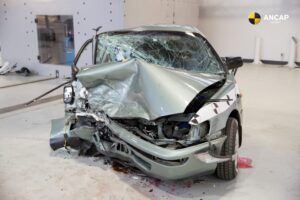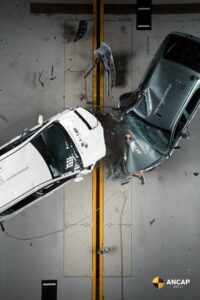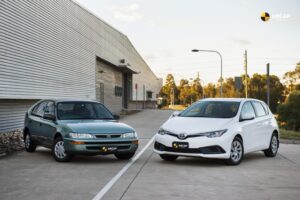If you had doubts about using a novated lease to get your family into a new vehicle these images should help you decide.
Australia and New Zealand’s independent vehicle safety advocate, ANCAP, today unveiled the results of a car-to-car crash test – dramatically demonstrating the improvements made in vehicle safety over the past two decades. This comes as new analysis shows older vehicles are over-represented in fatality crashes.
The crash test was conducted during the 4th United Nations’ Global Road Safety Week (8-14 May 2017) to highlight the important role safer vehicles play in improving road safety.
“This test physically illustrates the benefits of newer, safer cars,” said ANCAP Chief Executive Officer, James Goodwin.
Analysis of the Australian vehicle fleet shows that while older vehicles [those built 2000 or earlier] account for just 20% of the registered vehicle fleet, they’re involved in 33% of fatality crashes*. In contrast, newer vehicles [those built 2011-2016] make up 31% of the fleet yet are involved in just 13% of fatality crashes.
“It is concerning the rate of fatal crashes is four times higher for older vehicles than for new vehicles.”
“We’ve been tracking the average age of a vehicle involved in a fatal crash, and in just one year we’ve seen that average increase from 12.5 years to 12.9 years. This highlights the need for a renewed national focus and greater support for safer vehicles,” Mr Goodwin said.
The over-representation of older vehicles in fatal crashes is similar in New Zealand where the average age of the vehicle fleet is 14.3 years and the average age of a vehicle involved in a fatal crash is 15.6 years.
“It is unfortunate we tend to see our most at-risk drivers – the young and inexperienced, as well as the elderly and more frail – in the most at-risk vehicles, and we hope this test promotes a conversation to encourage all motorists to consider the safety of their car,” Mr Goodwin said.
“Safety is not a luxury and we want everyone to remain safe on the road, so consumers should look for the safest car they can afford and the safest car that suits their needs.”
“The outcomes of this test are stark and the automotive, finance and insurance industries can play a part to assist in encouraging people into newer, safer cars.”
The frontal offset test, which replicates a head-on crash, was conducted at 64km/h.
“The older car sustained catastrophic structural failure with dummy readings showing an extremely high risk of serious head, chest and leg injury to the driver. It achieved a score of just 0.40 out of 16 points – zero stars.”
“In contrast, the current model performed very well with a five star level of protection offered, scoring 12.93 out of 16 points,” said Mr Goodwin.











